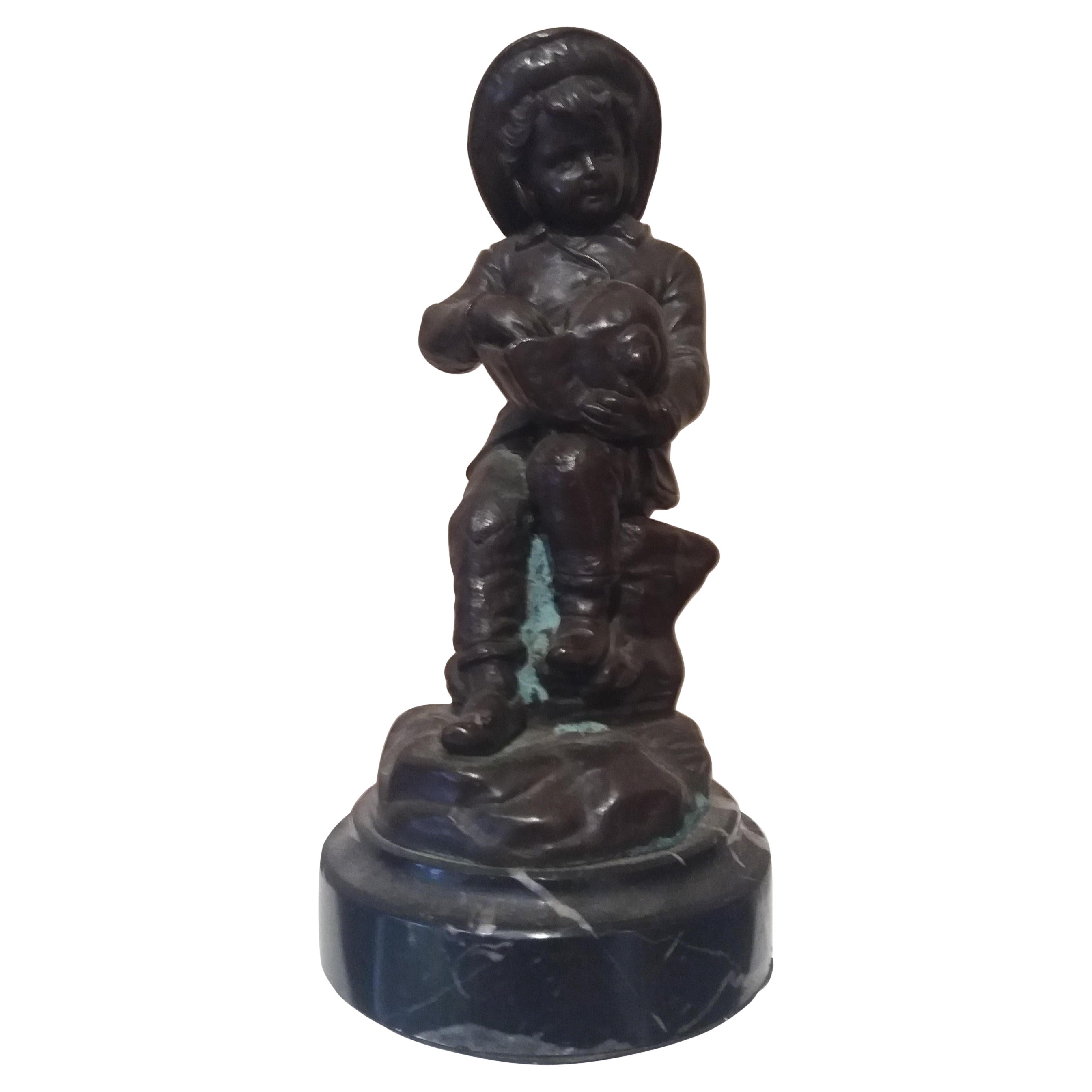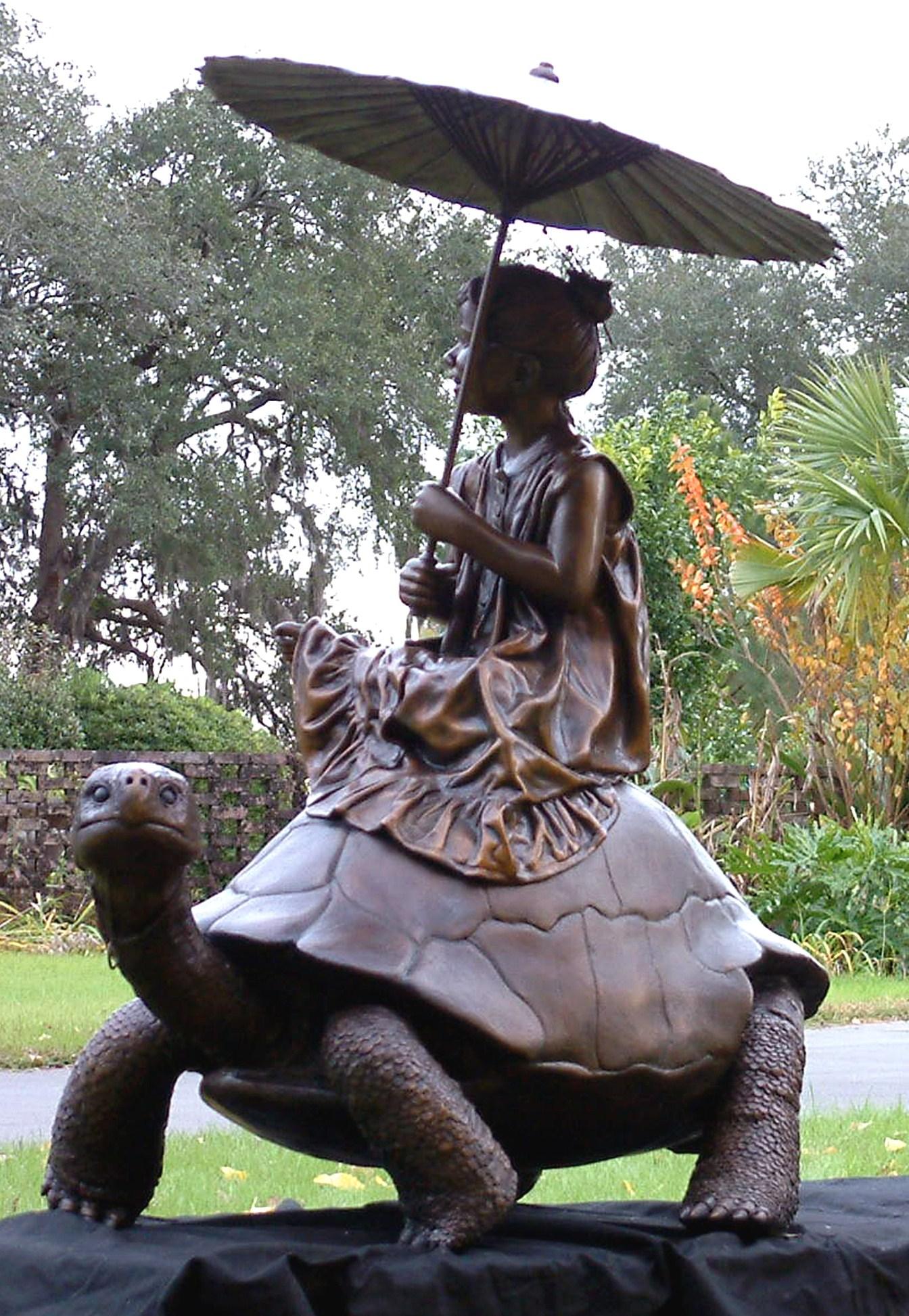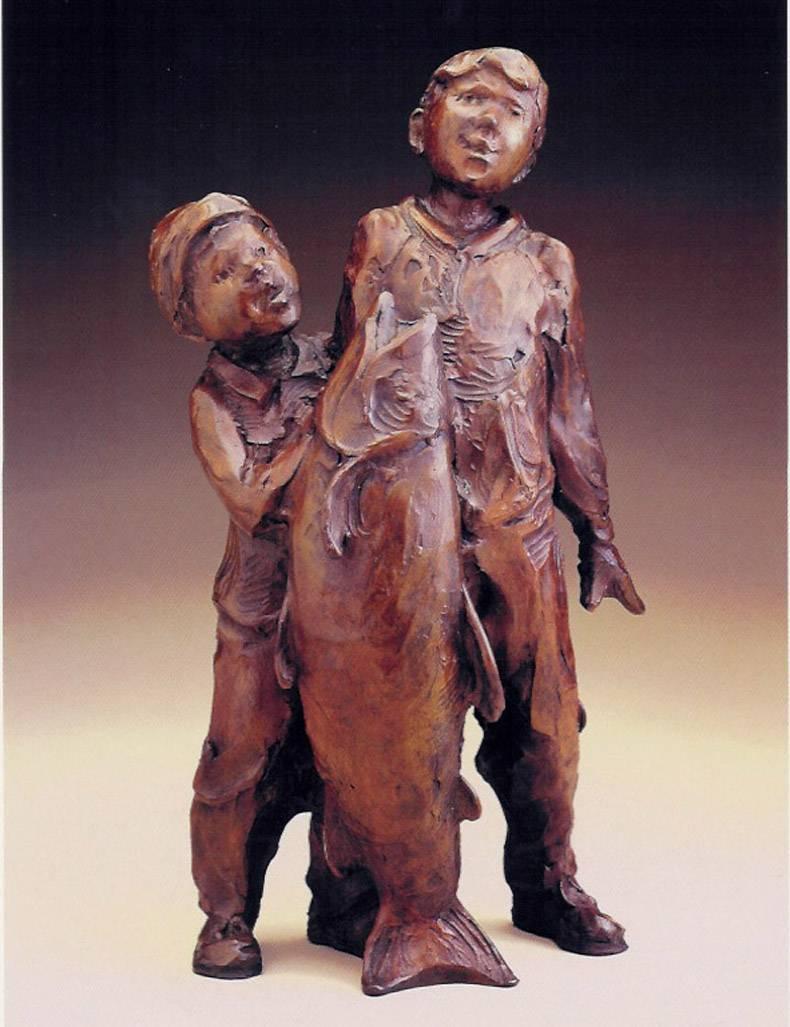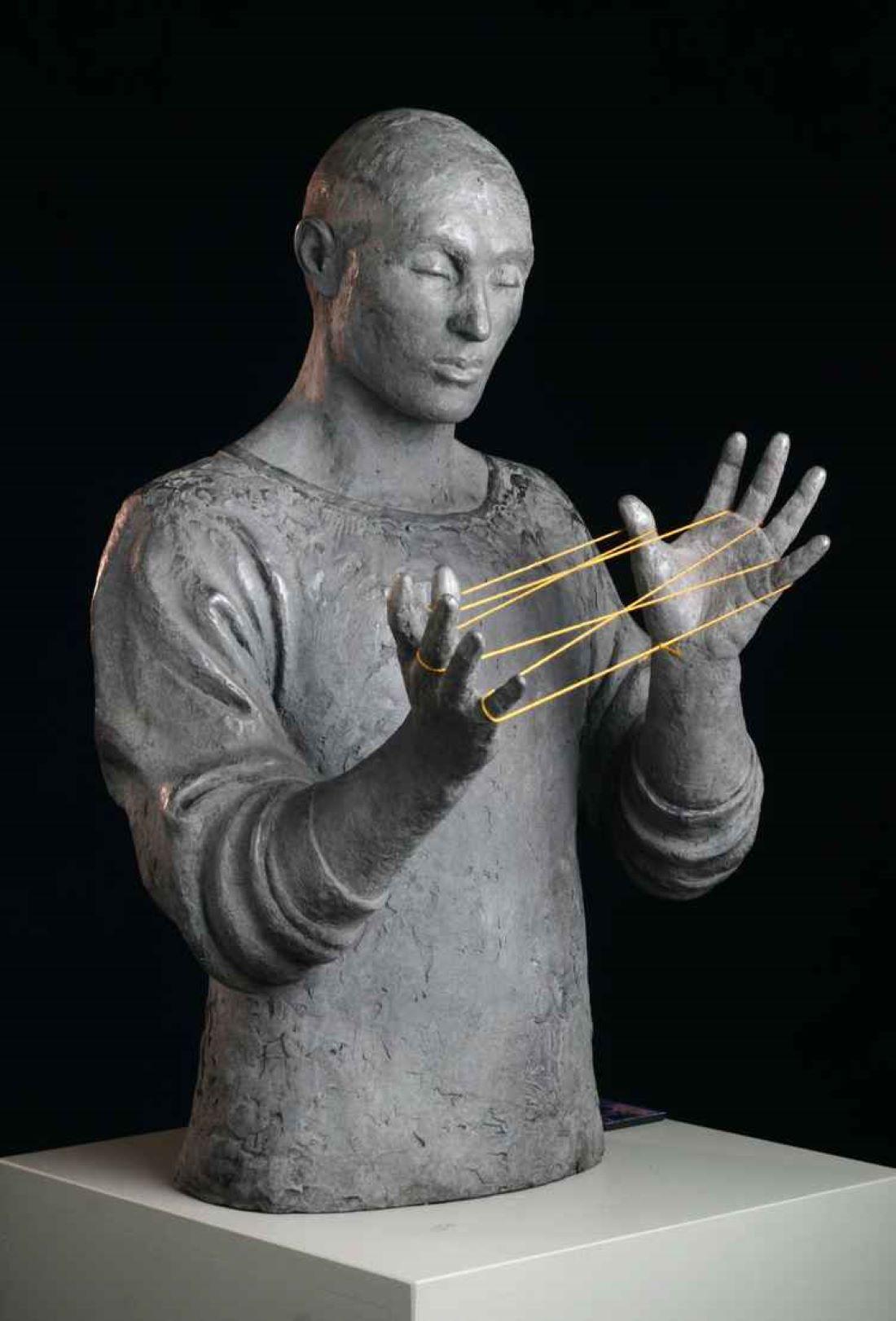Items Similar to Carpeaux etnic bronze : Le chinois (1868). N1 (scetch) Observatory fountain
Want more images or videos?
Request additional images or videos from the seller
1 of 11
Carpeaux etnic bronze : Le chinois (1868). N1 (scetch) Observatory fountain1868
1868
About the Item
JEAN-BAPTISTE CARPEAUX 1827 - 1875
Le Chinois N°1 (study for Asia) (1868). Model from the observatory fountain. Sketch
Height ca.60 cm
A similar copy auctioned on June 22, 2023, at Bonhams (Alain Delon: 60 Years of Passion) with an estimate of 30000 to 50000 euro.
Another bronze copy was sold at the Artcurial auction on November 18, 2020, for 52000 euro.
At Sotheby's on December 14, 2016, a similar copy was auctioned for £75000.
This beautiful bust of a young Chinese man, finely cast in bronze, represents a high point of Jean-Baptiste Carpeaux's oeuvre. Le Chinois is one of Carpeaux’s most sought after models, which he made in preparation of the monumental group of the fountain of l’Observatoire. In 1867, Baron Haussmann, then Prefect of Paris, commissioned the architect Gabriel Davioud, director of works for the city, to create this fountain for the Observatory garden. Davioud suggested that Jean-Baptiste Carpeaux be commissioned to design it. The genius of Jean-Baptiste Carpeaux layed in his ability to choose major themes that he transposed into original compositions. Once again, his group for the Observatory is surprising. The sculptor conceived a group of four figures embodying the Four Parts of the World, supporting the celestial sphere represented by a hollowed-out globe. Two of these allegories, Asia and Africa, were executed after a live model. Asia is represented by this Chinese man and Africa by a bust entitled "Pourquoi naître esclave ?" (Why be born as a slave)?
While Carpeaux has carefully modeled the features of his sitter, the bust’s title, Le Chinois (The Chinese Man), transforms this unknown individual into an idealized "type," or stand-in for an entire people.
The fountain was not executed until 1874, a year before Carpeaux's death, and finally the bust of the Chinese personifying Asia was adapted to a female figure in order to harmonize and balance the group.
Carpeaux made two different versions of Le Chinois :
- Le Chinois N°1 (1868). Esquisse. The 1868 version is sketchier and is characterized by a more spontaneous modelling.
- Le Chinois N°2 (1872) represents a more polished naturalistic version of the same model and was exhibited at the Salon of 1872 and in Brussels in 1874.
After the 1870 Prussian war and Jean-Baptiste Carpeaux's exile in England, the Atelier Carpeaux, a studio established to reproduce the artist's work, reopened its doors and began marketing the two versions of the bust of the Chinaman. Here, the sculptor was particularly innovative in also publishing the sketched version of the work (which, for the time, was a daringly modern move). The public appreciates the vitality of the model, the flat areas of material that enliven his costume and the movement of the face turned to the right, which multiplies the points of view.
The two versions of Le Chinois were produced by the artist’s atelier as soon as 1872, and then posthumously from 1875. Posthumous editions of both versions were made a.o. by the Susse-Freres manufactory as of 1914.
The two versions were also edited in different heights (ranging between 35 and 70 cm) and in different materials (terracotta, bronze and marble)
The presented model is a posthumous cast after the first 1868 version.
- Creation Year:1868
- Dimensions:Height: 23.63 in (60 cm)Width: 17.72 in (45 cm)Depth: 10.63 in (27 cm)
- Medium:
- Movement & Style:
- After:Jean-Baptiste Carpeaux (1827 - 1875)
- Period:
- Condition:
- Gallery Location:Gent, BE
- Reference Number:1stDibs: LU2140213585912
About the Seller
5.0
Vetted Seller
These experienced sellers undergo a comprehensive evaluation by our team of in-house experts.
Established in 2018
1stDibs seller since 2022
Typical response time: 1 hour
- ShippingRetrieving quote...Ships From: Gent, Belgium
- Return PolicyA return for this item may be initiated within 10 days of delivery.
More From This SellerView All
- A pair of ducks by Carl August Brasch.Located in Gent, VOVA very finely detailed and stylized bronze sculpture of a pair of ducks on a marble plinth. Signed C. Brasch. In terms of approach and style, this work is modern and somewhat reminis...Category
20th Century Figurative Sculptures
MaterialsMarble, Bronze
- Antoine - Louis BARYE (1795-1875)Tiger surprising an antelope BronzeBy Antoine-Louis BaryeLocated in Gent, VOVTiger surprising an antelope (terrace without profile) Bronze with a shaded green patina, circa 1880 Signed 'BARYE', stamped 'H' by the founder Brame Antoine-Louis Barye (1796-187...Category
19th Century Figurative Sculptures
MaterialsBronze
- Wilhelm KRIEGER (A) (1877-1945) Deer. Ca 1920Located in Gent, VOVThe deer. Circa 1920. Good quality bronze model of a doe, probably cast around 1970. Standing animal, looking forward, catching the scent, tense, dynamic posture characterized only b...Category
20th Century Figurative Sculptures
MaterialsBronze
- Akop GURDJAN (après) (1881-1948) Sitting Baboon BronzeLocated in Gent, VOVAkop GURDJAN (après)(1881-1948) Sitting Baboon Bronze Akop Gurdjan (1881-1948) Akop Gurdjan (also Hakob Gyurjyan) was born in Shusha (Nagorno Karabakh)...Category
19th Century Figurative Sculptures
MaterialsBronze
- Mare - hunting horse by Josuë Dupon 1864-1935Located in Gent, VOVA beautiful large bronze sculpture of a proud standing mare. Old sand cast created during the artist Josuë Dupon's lifetime. Josuë Dupon (also Josué or Josue Dupon) was a Flemish sculptor and engraver. His work also includes painting and graphics. He received his training through evening classes at the academy of Roeselare and Antwerp (1884) and later at the National Institute of Fine Arts (1887). In 1891, he won a gold medal with the monumental sculpture group Samson kills the lion and was runner-up in the Prix de Rome for sculpture. From that year on, his work appeared regularly in exhibitions at home and abroad. His reputation was such, that he became one of a select group of sculptors allowed by King Leopold II to carve statues in Ivory, which was imported from the Congo, the Belgian colony. In 1893 his exceptionally refined ivory statue of Diana was bought by the Antwerp Royal Museum of Fine Arts, which also acquired his spectacular bronze Vulture defending its prey a year later. Working in every genre and mastering every technique and material, Josuë Dupon became best known as a sculptor of exotic animals. He was equally capable of faithfully expressing anatomical detail as of rendering the animals' nature. Josuë Dupon was a technically faultless realist, with a sense of the dramatic, a feeling for decorative complexity and a tendency towards idealizing. The placement of his camel driver and two bronze groups at the entrance to Antwerp Zoo confirmed this reputation as animalier. The career that Dupon subsequently built, brought him numerous important awards and an appointment as professor at the Antwerp Academy, a tenure he held between 1905 and 1934. Besides animals, he sculpted busts, war memorials and public monuments. For one of the largest sculptural monuments and the largest fountain in the city of Buenos Aires, called Monument of the Two Congresses, he collaborated with his good friend, the Belgian sculptor Jules Lagae. Josuë Dupon created several statues of mighty condors for this monument. At the start of his career his conception of art was strongly influenced by traditional 19th century artistic ideals. After the turn of the century his compositions and surface treatment changed and became more modern. He met Rembrandt Bugatti around 1905 or 1906 in the 'Jardin des Plantes' in Paris and invited him to Antwerp. Bugatti began travelling to Antwerp in 1906 to observe and sculpt the inhabitants of its zoo, which was then considered the best in the world, and Dupon allowed Bugatti to stay with him during several of his early visits. As such Dupon became a friend and a bit of a father figure to Rembrandt Bugatti. Dupon did not play a very active part in artistic movements or associations. Dupon remains an important sculptor not only through his body of work but also because of the influence he exercised through interactions and collaboration with other sculptors such as Lagae, Bugatti and Bourdelle but also because he trained leading sculptors such as Albéric Collin (1886-1962), Willy Kreitz...Category
19th Century Figurative Sculptures
MaterialsBronze
- Sea Lion by Greta van Puyenbroeck (1943- )Located in Gent, VOVsea lion Artist: Greta van Puyenbroeck Dimensions: 22 h x 44 l x 30 cm w without base with base 29 x 33 x 38 cm Foundry: Artcasting Sign Greta Van Puyenbroeck was born in Antwerp in ...Category
20th Century Figurative Sculptures
MaterialsBronze
You May Also Like
- Bollel Child and conch shell. Original multiple bronze sculptureLocated in CORAL GABLES - MIAMI, FLBOLLEL. Child and conch shell. Original multiple bronze sculptureCategory
1980s Realist Figurative Sculptures
MaterialsBronze
- TURTLE TRAINBy W Stanley ProctorLocated in Tallahassee, FLLife size child on life size tortoise. Combination of young child's imagination and reality.Category
21st Century and Contemporary Realist Figurative Sculptures
MaterialsBronze
- "On the Wings of an Eagle", Chester Fields, Bronze and Steel Sculpture, 54x40x24By Chester FieldsLocated in Dallas, TX"On the Wings of an Eagle by Chester Fields is one of his most popular sculptures. This is number 26 of 75 made. It is made with the following: Bronze Casting Deluxe Patina Gold Beak...Category
1990s Realist Figurative Sculptures
MaterialsBronze, Stainless Steel
- Antique Dog: Bulldog Playing with a Mouse- Henri Émile Adrien Trodoux ca. 1870sLocated in SANTA FE, NMAntique Bronze Dog Bulldog Playing with a Mouse on Sheaves of Wheat Henri Émile Adrien Trodoux (1815-1881) 6 1/8 x 3 7/5 inches Signed on the terrace Henri Émile Adrien Trodoux (Fre...Category
Mid-19th Century Realist Figurative Sculptures
MaterialsBronze
- Big Fish StoryBy Jane DeDeckerLocated in Greenwich, CTSculpture of two boys displaying a sizeable catch.Category
1990s Realist Figurative Sculptures
MaterialsBronze
- Cat's CradleBy Bill StarkeLocated in Denver, CO"Cat's Cradle" is a limited edition sculpture created by Bill Starke depicting a figure playing with string. About the artist: Human beings interacting, colliding, cooperating, striving, & achieving are the themes I wish to portray in my sculptures. My observations on the human condition are meant to be both humorous and thought provoking. Bill Starke's "Free Man" is everything that good art should be: technically superb, brilliantly composed, emotionally powerful and visually arresting... like George Stubbs, the 18th century English master...Category
2010s Realist Figurative Sculptures
MaterialsBronze
Recently Viewed
View AllMore Ways To Browse
Original Antique Bronze Sculpture Art Sculptures
Gold Fountain
Points Bronze
Bronze Fountain Sculpturers
Lay Models
Bust Of African
Sculptors Modeling Stand
Modern Marble Garden Sculpture
People Cast Bronze Sculpture
Celestial Sculpture
African Face Sculpture
Sothebys Antique Auction
Antique Bronze Fountain
Antique Bronze Fountains
Female Bronze Bust
Antique African Art Sculpture
Antique Bronze Sculptures China
China Bronze Figure





